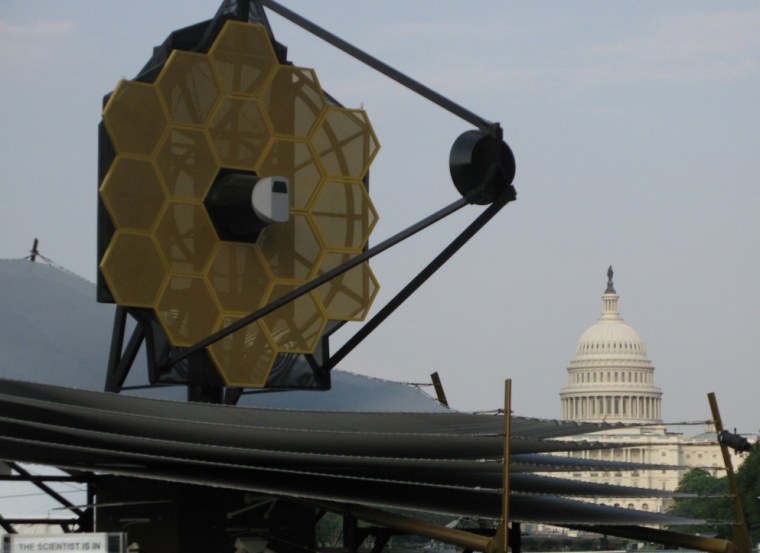Federally funded researchers are facing months of uncertainty due to the budget-cutting battle that's unfolding in Washington. But policy experts say one outcome seems virtually certain: The long-term prospects for research and development are looking dimmer.
"I don't think that people are very optimistic," said Patrick Clemins, director of the R&D Budget and Policy Program at the Washington-based American Association for the Advancement of Science.
One might be tempted to say, "Join the club." When it comes to projecting the federal government's budgetary future, optimism is in short supply right now. But the outlook for research and development is particularly murky because it takes years for the most ambitious and costliest projects to bear fruit — and that's exactly the time frame that's most challenging for budget planning.
The short-term deal that was put in place last week to avert a debt crisis actually wasn't as bad as Clemins and other budget-watchers had feared. A week ago, ScienceInsider's Jeffrey Mervis wrote that "there may yet be a silver lining for U.S. scientists," in that the deal was kinder to discretionary spending than the House version of the fiscal 2012 budget. About $24 billion kinder.
Mervis speculated that the extra give in the budget might provide an opportunity to reconsider a House proposal to kill the James Webb Space Telescope, which is considered the heir to the Hubble Space Telescope. But reports of the space telescope's resurrection, and any other silver linings on the budgetary cloud, may be greatly exaggerated.
Short term vs. long term
Clemins said the likeliest outcome for the 2012 budget would be just enough of an increase to keep pace with inflation.
"It could be better, it could be worse, but inflationary increase are something we can deal with," he told me. "I think the real challenge is going to come when more discretionary-spending cuts come through the sequestration process or the committee budgetary process."
Looking beyond 2012, things get tougher. Many of the $914 billion in cuts already agreed upon won't take effect until 2014 or later. In the meantime, lawmakers have set up a process by which a 12-member "supercommittee," evenly divided between Republicans and Democrats, would be charged with finding at least $1.2 trillion in additional cuts over the next decade. If the cuts can't be implemented by 2013, across-the-board cuts would take effect automatically.
Michael Lubell, director of public affairs for the American Physical Society, figures that there'd be an 11 percent reduction in the flow of federal money going to science programs.
"It is hard to see how American science could avoid serious long-term contraction under the legislation approved — unless the economy grows very substantially and federal revenues increase accordingly," Lubell said in his analysis.
Top targets on the hit list
Although the supercommittee's members haven't yet been named, Clemins can already guess which targets will be the first to come up for consideration. "Anything that's been in the news before for cost overruns or potential management issues is going to be at the top of the list, and that's why the Webb Space Telescope came up," he said.
NASA has already spent $3.5 billion on the telescope, and it's expected to require $3 billion more over the course of its construction and operation. At one point, NASA thought the telescope could be launched as early as this year — but the latest estimate points to 2018 as the earliest launch date.
On the defense side of the R&D budget, the troubled F-35 stealth fighter project could be in similar trouble, Clemins said. The F-35, also known as the Joint Strike Fighter, is looked upon as a key component in the Pentagon's post-Cold War air strategy — but the project has been plagued by cost overruns and schedule delays, making it a prime target for cutbacks.
If history is any guide, national laboratories and high-energy physics research could also be in for significant cutbacks. In the past, the Energy Department's Office of Science has faced the prospect of double-digit reductions, with the potential for drastic staff reductions or shutdowns at high-profile facilities such as Fermilab in Illinois. The U.S. contribution to the ITER nuclear-fusion program could once again be in peril, just as construction is due to ramp up for the $21 billion international project. (ITER is now slated to begin operation no earlier than 2019.)
Nature's Eric Hand reports that granting agencies such as the National Institutes of Health and the National Science Foundation might have to reduce their grant-acceptance rates to single digits, and he quotes the Association of American Universities' Barry Toiv as saying there's "not a chance" that academic institutions could make up the gap. For months, the NSF has been high on the budgetary hit list, and it's hard to imagine there won't be more scrutiny.
Is now the time to bemoan the state of American scientific prowess and technological competitiveness? It's a bit too early for that. "Anything now is just speculation," Clemins said. "We're going to have this whole discussion again in December," when Congress is supposed to consider the supercommittee's budget-cutting plan.
But it's not too early to contact your congressional representatives and tell them about your priorities for future spending, including investments in research and development. And while you're at it, feel free to weigh in with your comments below.
More on politics and science:
- Will our 'Sputnik moment' fizzle out?
- Funny science sparks serious spat
- NASA chief to Congress: Save our telescope
- How politics will spin science
Connect with the Cosmic Log community by "liking" the log's Facebook page or following @b0yle on Twitter. You can also add me to your Google+ circle, and check out "The Case for Pluto," my book about the controversial dwarf planet and the search for new worlds.
